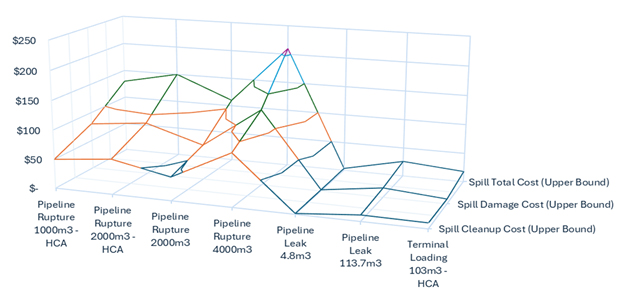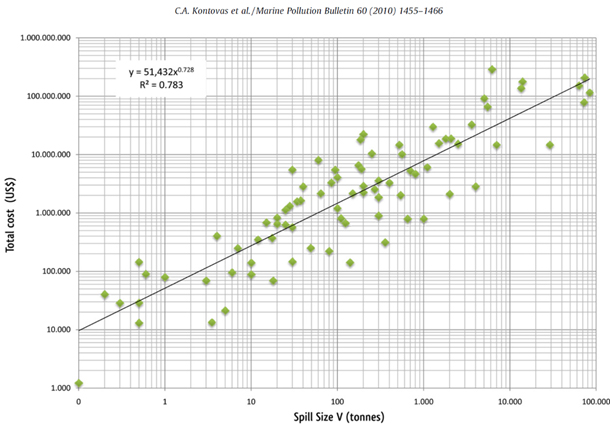The Economic Impact of Oil Spills:
Making the Case for Early Detection
Executive Summary
Oil spills represent one of the most significant environmental and economic risks faced by the energy industry today. This whitepaper examines the true costs of oil spills, both direct and indirect, and presents a compelling case for implementing early detection systems as a cost-effective preventive measure. Drawing from extensive research and real-world data, we demonstrate how investing in advanced leak detection technology, specifically Leakwise sensors, can provide substantial return on investment by preventing or minimizing the impact of potential spills.
1. The True Cost of Oil Spills
1.1 Understanding the Financial Impact
The costs associated with oil spills extend far beyond the immediate cleanup expenses. Based on comprehensive research, including Dr. D. Etkin’s work for the EPA (2004), oil spill costs can be categorized into three main components:
- Response Costs: Direct expenses related to containment and cleanup
- Socioeconomic Damages: Impact on local communities and businesses
- Environmental Damages: Long-term effects on ecosystems and wildlife
1.2 Factors Influencing Spill Costs
Multiple factors affect the total cost of an oil spill:
- Spill Volume: Larger spills generally incur higher costs, though not linearly
- Oil Type: Heavy oils typically cause more damage and are costlier to clean up
- Location: Spills in sensitive areas like wetlands or near drinking water sources are more expensive
- Response Time: Faster response can significantly reduce overall costs
1.3 Cost Breakdown by Oil Type
Based on the EPA’s Basic Oil Spill Cost Estimation Model (BOSCEM), per-gallon costs (US 2004 prices) vary significantly by oil type:
| Oil Type | Response Cost ($/gal) | Socioeconomic Cost ($/gal) | Environmental Cost ($/gal) |
| Light Fuels | $85 – $440 | $80 – $330 | $25 – $85 |
| Heavy Oils | $154 – $386 | $175 – $600 | $35 – $95 |
| Crude Oil | $118 – $220 | $60 – $300 | $30 – $90 |
2. The Case for Early Detection
2.1 Prevention vs. Cleanup
Studies consistently show that preventing oil spills or detecting them early is far more cost-effective than dealing with their aftermath. Early detection systems can:
- Minimize the volume of oil spilled
- Reduce response time and associated costs
- Prevent or reduce environmental damage
- Avoid costly regulatory fines and litigation
2.2 The Leakwise Solution
Leakwise oil leak detection sensors offer a proven, cost-effective solution for early detection:
- Rapid Response: Detection within 30 seconds of a leak occurring
- Reliability: Over 6,500 units installed across 50 countries
- Cost-Effective: One-time investment of approximately $10,000
- Versatility: Suitable for various applications and environments
2.3 Key Features
- Continuous online monitoring with self-diagnostics
- Certified for hazardous areas (Intrinsically Safe)
- Low maintenance requirements
- Detection of oil layers as thin as 0.3 mm
3. Cost-Benefit Analysis
3.1 Investment vs. Potential Losses
The average cost of a significant oil spill can range from millions to hundreds of millions of dollars., as seen in the following figure 1:

Figure 1: Spill cost of Several Scenarios (US$ millions, adjusted to 2024 prices)
3.2 Model Validation
To validate the theoretical model, the following figure 2 presents actual spill costs which were collected by researchers from National Technical University of Athens:
An empirical analysis of IOPCF oil spill cost data (2010), Christos A. Kontovas *, Harilaos N. Psaraftis, Nikolaos P. Ventikos, National Technical University of Athens, Greece

Figure 2: Validating the order of magnitude of theoretical dpill cost with real numbers
Figures in this real-world oil spill events well fit with the theoretical model. While comparing these costs with the typical cost of an oil leak detection system, as shown in figure 3, the economical benefit of the last becomes very clear.

Figure 3: Real costs of oil spills, compared with the cost of an oil leak detection system
3.2 Case Study: Cost Savings
Based on the EPA’s oil spill cost data from 1980-2002:
- Average annual cost of oil spills: $2.7 billion
- Total cost over 23 years: $63.2 billion
These figures emphasize the potential savings that could be achieved through early detection and prevention.
1. Regulatory Compliance and Risk Mitigation
4.1 Regulatory Framework
Oil spill prevention and response are heavily regulated. Early detection systems help companies:
- Meet or exceed regulatory requirements
- Demonstrate due diligence
- Reduce potential liability
4.2 Risk Mitigation Strategy
Implementing Leakwise sensors as part of a comprehensive risk mitigation strategy:
- Reduces the likelihood of major spills
- Minimizes potential financial losses
- Protects company reputation
- Demonstrates environmental responsibility
2. Conclusion
The implementation of early detection systems, particularly Leakwise sensors, represents a smart investment for any company involved in oil handling or storage. With potential spill costs running into millions of dollars and averaging $2.7 billion annually across the industry, the modest one-time investment in prevention technology is not just economically prudent but essential for responsible operation in the modern energy sector.
References
- Etkin, D.S. (2004). Modeling Oil Spill Response and Damage Costs. Proceedings of the 5th Biennial Freshwater Spills Symposium.
- EPA Basic Oil Spill Cost Estimation Model (BOSCEM)
- Leakwise Technical Documentation and Case Studies
For more information about Leakwise oil leak detection systems and to request a customized cost analysis for your facility, please contact Leakwise www.leakwise.com info@leakwise.com .
